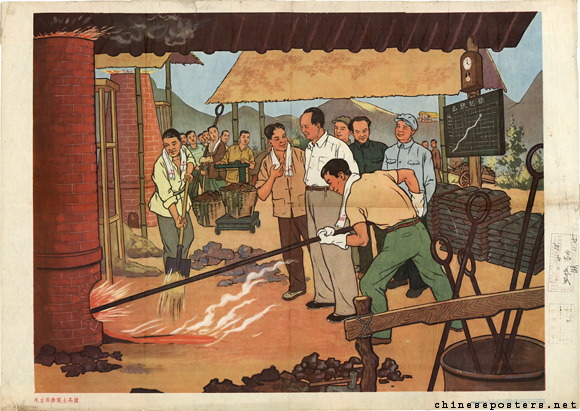The time period of the Second Five Year Plan
1958-1961
The term used for the integration of cooperatives
Communes or Collectives
Grain was needed to fund industrial production
Challenges with communes
Communes built on collective efforts
i.e those who did less work still recieved the same amount of food.
The name given to the time period of 1959-1961
The Three Bad Years
Number of communes by the end of 1958
Over 26, 000 operating (Sowdon, p.169) (Ryan, p.185)
Challenge with 'Work Points'
Everyone received the same points, based on their category of worker.
There was no change based on age, or disability, and you did not receive bonus for working more hours than anyone else; you could not change your points.
Similarly, if you were assigned a project that took longer than another group, you did not receive more points.
Modernise China through rural collectivisation and communal services
Number of people in a commune
"Averaged 5000 households, with populations of up to 100,000 people" (Ryan, p.185)
"Twelve families would make a 'work team' [in the commune], with 12 work teams making up a brigade" (Sowdon, p.169)

"Eliminate the 4 Pests!"
"From 1956 onwards, mice, sparrows, flies, and mosquitoes should absolutely be eliminated in all possible places within 12 years. Killing sparrows serves to protect crops. Sparrows in cities and forest areas do not necessarily have to be eliminated. " January, 1958.
A campaign attempting to stop these animals from eating grains and crops that were desperately needed so that steel production could be boosted.
Explain the decline in Sparrows
Sparrows were almost completely eradicated, which meant that the bugs (like locusts that also ate crops) that were usually controlled by the sparrows became a deeply signifnanct ecological problem.
Mao later removed sparrows from this campaign and replaced them with bedbugs.
Grain Production needed to increase to hep fund Industrial Production.
Collectivisation (1956) failed to improve grain production.
Industrial Production had achieved some levels of success but there was still plenty of work
CCP wanted to free women from domestic duties and mobilise them into a labour force.
Outline features of communes
-collective ownership and farming of land (no private plots)
- small land plots were combined into massive sites that were tilled by hundreds and even thousand of workers at a time
-tools, livestock, and other similar possessions became collectively owned
-instead of wages, people received work points to use for buying clothing and everyday items
(Ryan, p.185)
- A typical commune averaged 10,000 acres of arable land with collective responsibility for 100,000 livestock (Gates and Morgan, p.173)
- People required special passports to travel between communes (Gates and Morgan, p.172)

Backyard steel furnaces, which ultimately failed as a economic project.
This campaign impacted future campaigns, as household tools were used to feed the furnace fires, and melted to try and create steel.
Outline impacts of the Great Famine
Tens of millions of peasants starved; estimates range from 30 to 45 million deaths.
Malnutrition and disease devastated villages; many were left deserted.
Grain intended for survival was instead taken for urban centers and state projects.
Explain the shift from collectives to communes.
Mao believed regulations "held back the creative forces of the masses" (Ryan, p.183), and that by establishing communes instead of cooperatives, in which things like communal kitchens, laundries and similar were intended to "free labourers for work in the field" (Sowdon, p.169).